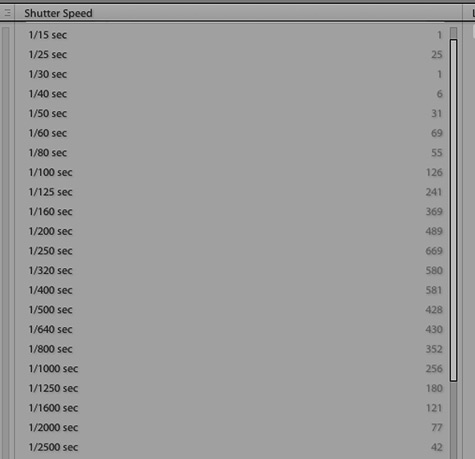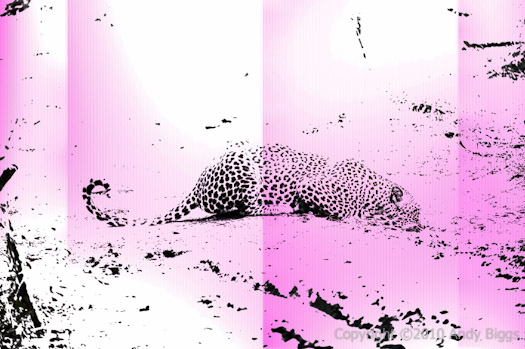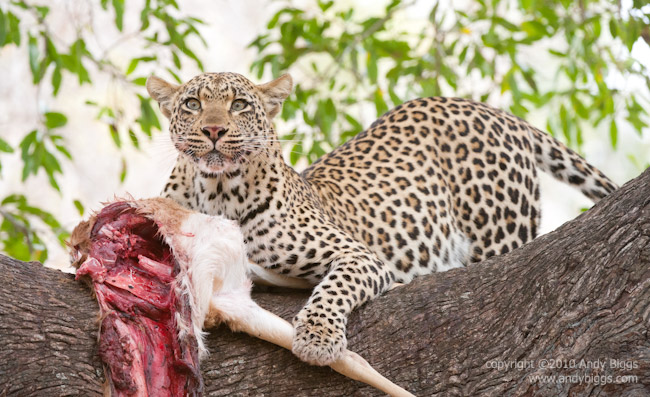I have been back from South Africa for a few weeks now, and I have had some time to reflect on my past safari. First off, the goal of the safari was to lead a small and intimate group of photographers (7 in total) to photograph the predators of the Sabi Sands, South Africa. The Sabi Sands is a very unique location for wildlife photography, as the density of leopards and lions are some of the highest in all of Africa. I think I have a very soft spot for leopards, for sure, and I can always use more photographs in my portfolio.
We spent 8 nights in the Sabi Sands, split between Exeter River Lodge and Mala Mala Main Camp (4 nights each). We had 16 separate leopard sightings in 8 days, which is a remarkable number. Of those 16 sightings, we saw 12 unique individuals, some nice interaction between some of them as well as a thrilling almost-kill of a warthog (see earlier Photo of the Day posting).
The weather was in transition from the spring into the summer temperatures, and we had some needed rain near the end of the safari. The western sector of the Sabi Sands has had ‘controlled burns’ already over the past few months, and Mala Mala always chooses to do their own controlled burns after the first 50mm of rain. This meant that as the rains started to happen on our 6th day, the wildlife moved in a way that made for challenging photography: where did they all go? Most of our sightings happened in the first 5 or 6 days, and the last few days were exercises in opportunistic photography. When I plan my safaris, I always choose to split my time between multiple locations, just in case of migratory or weather changes that can snub even the most opportunistic photographer. You just have to play the odds.
Ok, so here are some things that worked and what did not. I took 3 cameras: a Nikon D3, a Nikon D3x and a Sony NEX-5. The NEX-5 was only intended to be a grab shot camera, plus perhaps some video. After looking at my 5181 images in Lightroom (after culling some out of focus images), here is a breakdown of some interesting statistics:
- D3 = 2160 frames
- D3x = 3021 frames
I bought a D3x back in December of 2008, and sold it about 9 months later. I sold it because I thought I needed to rely heavily on ISO 1600 and above ISO speeds most of the time. This is sort of true, but I felt guilty for owning an $8,000 camera that I used 20 percent of the time. Well, after looking at my past safari images that were taken with the D3x at ISO 800, 1600 and perhaps up to 2500, I realized that I had a knee jerk reaction to sell the camera. At 20x30” print sizes, the 24mp resolution of the D3x balances out all of the excess noise. The Nikon D3 at ISO 2500 has less resolution and less noise, but more dynamic range than the D3x. In actual prints, I have to say that the D3x looks better to my eyes on these somewhat higher ISO speeds. So, a few days before I left for Africa I decided to stop using my D700 and D300 cameras and got back into the D3 and D3x bodies. I very very happy that I did this, because I missed the pro-level build quality of these cameras. And the D3x files are oh-so gorgeous, with the dynamic range and extra resolution at ISO speeds up to about 800, perhaps 1600. Yes, the D3x isn’t the best at ISO 800, but it is still preferable to my eyes when compared to the D3.
Here are some numbers as to what ISO speeds I shot at:

As you can see, my ISO speeds were all over the board. ISO 800 and 1600 are the most popular ones, for sure. A truism: I tend to have more light and lower ISO values on my east Africa safaris, as they are more wide open savannah environments, and my Botswana and South Africa safaris tend to have less light and higher ISO values, due to the more dense trees and bushes.
Ok, so now what did my typical shutter speeds look like?

This is actually not that interesting. I always try to get as much shutter speed as I can get, however I am always aware of depth of field considerations. The balance between ISO, shutter speed and depth of field is always something that requires a trade-off, as one can never have all three be perfect for all situations. I do recommend that all photographers understand what their absolute minimum shutter speed is for a given focal length, as this is essential information when pushing the boundaries of ISO, shutter speed and depth of field. In my own experience, I do feel comfortable going down to about 1/60 or 1/125 at 400mm when working in a vehicle that is very still.
Ok, so which lenses were the most popular?

For you smart people out there, the 5200 shots represents all 3 of the cameras, including the NEX-5. I chose to ignore it for this graphic, as I think some of the metadata is messed up with the lenses on the Sony. Another post on another day, perhaps. Well, the 200-400mm was used for more than 50% of my shots, and the 70-200mm was used quite a bit. I think it is time for me to upgrade to the new Nikon 70-200mm f/2.8 VR II lens, as it is a huge improvement in quality over the one that I own. What is interesting is that I rarely use the 70-200mm when I am in Tanzania or Kenya, primarily because the wildlife is so much farther away.
What worked and what did not
I was hoping to do a little video with my new Sony NEX-5, and I did do some. What didn’t work was I just couldn’t find the time to do much of it, because we were so darned successful with our still photographs on game drives. I was hoping to video some traveler testimonials, as well as to do some informational shooting regarding how the vehicles look, how we shoot from them and what our accommodations look like. I have learned that shooting video and stills on the same trip just doesn’t work, and I have to give up game drives in order to do quality video production. It’s just that simple. My assistant, Troy, came on the prior safari to Botswana and South Africa, and he recognized the same thing. In the future I am just going to outsource this video work to Troy, so I can focus on leading the safaris, as well as taking some still photographs.
I loved the reduced equipment list on this trip, as I didn’t take an all-purpose zoom lens for general shots. So I left the 24-70mm behind, as well as my JVC GY-HM100U video camera. I did have a new Gura Gear prototype bag with me, and I was quite happy with how it performed. No, I cannot mention anything about the bag, but I will say that we are actively working on new products right now.
I am thinking of picking up a 3rd SLR for other grab shots, as well as for video. The D7000 is what I have my eyes on right now, or perhaps upgrading from the D3 to the D3s. I really wish that Nikon would put some more weight behind video, as I would like a camera that can do 60 frames per second for slow motion of wildlife. Just my $.02.
OK, I did have an issue with my D3. Here is the situation: We were tracking a leopard, and I forgot to change my manual settings when she decided to stop to take a drink. My settings were still set to expose as if she were sitting up in a tree (overexposed). So my only shot of her drinking was grossly overexposed, and when I took a look in Lightroom at the file, I noticed some serious banding. I pushed the boundaries some more by tweaking the Exposure (minus 4 stops) and Blacks (+100) , and as you can see I had some seriously bad banding, as well as color shifts. Anybody have an ideas as to if this is normal or not?

Where to go from here?
Well, since this safari was such a huge success, I have decided to make this safari a yearly thing. Greg du Toit will be running this same itinerary next year, and we are working on the details right now. We are looking at the first few weeks of August. My safari customers are always looking for unique photographic opportunities, and just the mentioning of leopards and lions on a specialized safari whets their appetite.
 Friday, April 1, 2011 at 04:49PM
Friday, April 1, 2011 at 04:49PM 
 Exeter,
Exeter,  Leopards,
Leopards,  Mala Mala,
Mala Mala,  Sabi Sands,
Sabi Sands,  South Africa in
South Africa in  Photo of the Day,
Photo of the Day,  Safaris
Safaris 





